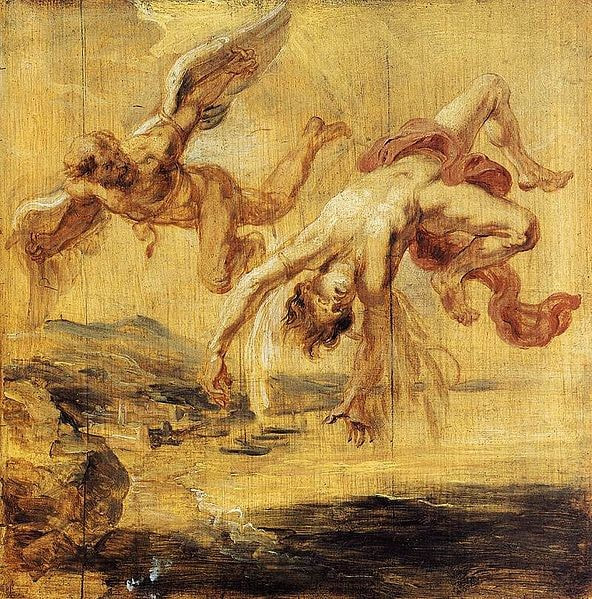One area we haven’t yet looked is that of asteroids in orbits closer to the Sun than Mercury. In 1855 the great French astronomer Urbain LeVerrier (b.1811 d.1877), famous for his calculations leading to the discovery of the planet Neptune, calculated that the precession (the gradual rotation) of the perihelion point of the planet Mercury could not be explained using Newtonian gravitation based upon the then known planets. The precession of Mercury’s orbit has since been explained, in November 1915 by Albert Einstein (b.1879 d.1955) using the theory of general relativity (GR).
Nous n’avons pas encore considéré les astéroïdes en orbite plus proches du Soleil que Mercure. En 1855 l’astronome français Urbain LeVerrier (1811 -1877), célèbre pour ses calculs qui ont mené a la découverte de la planète Nepture, a calculé qu’il n’était pas possible d’expliquer la précession (mouvement de rotation progressif) de la périhélie de la planète Mercure en utilisant la gravitation newtonienne. Mais en novembre 1915 la précession de l’orbite de Mercure a expliqué par Albert Einstein (1879–1955) en utilisant la théorie de la relativité générale.
However, as GR was unknown until the early 20th century, an alternative and plausible explanation was put forward by LeVerrier in a paper he presented on 12th Sept 1859 to the Academy of Science. He proposed that there existed another small planet interior to the orbit of Mercury and it was this that was leading to the discrepancy in the Mercurian orbit. This hypothetical planet was named Vulcan after the Roman god of fire and volcanoes. The name Vulcanoid is given to any object which has an orbit wholly contained within the orbit of Mercury (i.e. a < 0.38AU) and several astronomers have been involved in searches for this type of object. James Watson (b.1838 d.1880), as director of the Detroit Observatory, was a strong proponent.
From a gravitational perspective, there is a region of stability for low-eccentricity orbits of semi-major axes from ~0.07 to 0.21 AU (15 to 45 solar radii). The inner limit is sensitive to non-gravitational forces and effects such as evaporation (due to the intense solar radiation at that distance), the Poynting - Robertson and the Yarkovsky effects (which we will look at in future blogs). The region beyond the outer part of this region (i.e. a > 0.21AU and up to 0.38AU, Mercury’s orbit) is an unstable location for any orbiting body due to the perturbation effects from the planets Mercury and Venus.
More recently, data analysed from solar probes such as NASA’s SOHO and STEREO and the Messenger probe to Mercury have not detected any Vulcanoids. The most recent of these analyses have concluded that there are no Vulcanoids with e ≤ 0.15 or i ≤ 15º and that a maximum residual population of any primordial Vulcanoids would contain < 75 objects with dimension >1km.
The European Space Agency Solar Orbiter (SolO) mission, recently in the news ahead of its planned launch in February, and the NASA Parker Solar probe, already in-situ, will observe the Sun from within the orbit of Mercury. However, both probes are on eccentric orbits with aphelia (furthest points from the Sun) far beyond the orbit of Mercury. Hence, they are not artificial-Vulcanoids.
So do Vulcanoids exist?
It’s probable that some fragments from the early solar system still exist in sub-Mercurian orbit. However, any such objects are unlikely to be observed until we develop a large-scale solar system radar-type facility – which as far as we are aware, is not on any institutions plans.
So why bother looking?
Any residual objects within this region will be of significant cosmogenic importance (i.e. they will help improve models of the early solar system and its dynamical evolution.
Further reading
Searching for Vulcanoids
H Campions et al. ASP Conference series 107/85-96 1996
http://adsabs.harvard.edu/full/1996ASPC..107...85C
The full conference proceedings can be read at http://www.aspbooks.org/a/volumes/table_of_contents/?book_id=219
A search for Vulcanoids with the STEREO Heliospheric imager
A J Steffl et al. Icarus 223/1/48-56, March 2013 and http://arxiv.org/abs/1301.3804 Jan 2013
Search for Vulcanoids and Mercury satellites from Messenger
W. Merline et al. 47th Lunar and Planetary Science Conference, March 2016
https://www.hou.usra.edu/meetings/lpsc2016/pdf/2765.pdf


